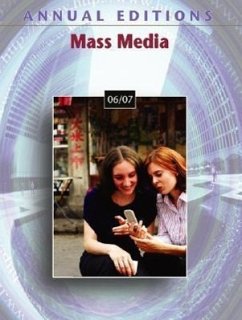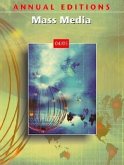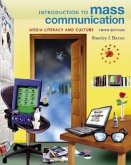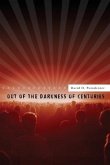- Broschiertes Buch
- Merkliste
- Auf die Merkliste
- Bewerten Bewerten
- Teilen
- Produkt teilen
- Produkterinnerung
- Produkterinnerung
This thirteenth edition of ANNUAL EDITIONS: MASS MEDIA provides convenient, inexpensive access to current articles selected from the best of the public press. Organizational features include: an annotated listing of selected World Wide Web sites; an annotated table of contents; a topic guide; a general introduction; brief overviews for each section; a topical index; and an instructor's resource guide with testing materials. USING ANNUAL EDITIONS IN THE CLASSROOM is offered as a practical guide for instructors. ANNUAL EDITIONS titles are supported by our student website, www.mhcls.com/online.
Andere Kunden interessierten sich auch für
![Annual Editions: Mass Media 03/04 Annual Editions: Mass Media 03/04]() Joan GorhamAnnual Editions: Mass Media 03/0426,99 €
Joan GorhamAnnual Editions: Mass Media 03/0426,99 €![Annual Editions: Mass Media 04/05 Annual Editions: Mass Media 04/05]() Joan GorhamAnnual Editions: Mass Media 04/0527,99 €
Joan GorhamAnnual Editions: Mass Media 04/0527,99 €![Clashing Views in Mass Media and Society Clashing Views in Mass Media and Society]() Clashing Views in Mass Media and Society68,99 €
Clashing Views in Mass Media and Society68,99 €![Politics and the Mass Media in Britain Politics and the Mass Media in Britain]() Ralph NegrinePolitics and the Mass Media in Britain34,99 €
Ralph NegrinePolitics and the Mass Media in Britain34,99 €![Introduction to Mass Communication, Updated Media Enhanced Edition with Powerweb Introduction to Mass Communication, Updated Media Enhanced Edition with Powerweb]() Stanley J. BaranIntroduction to Mass Communication, Updated Media Enhanced Edition with Powerweb145,99 €
Stanley J. BaranIntroduction to Mass Communication, Updated Media Enhanced Edition with Powerweb145,99 €![Out of the Darkness of Centuries: A forty five year odyssey to discover the use of mass media for human betterment Out of the Darkness of Centuries: A forty five year odyssey to discover the use of mass media for human betterment]() David O. PoindexterOut of the Darkness of Centuries: A forty five year odyssey to discover the use of mass media for human betterment24,99 €
David O. PoindexterOut of the Darkness of Centuries: A forty five year odyssey to discover the use of mass media for human betterment24,99 €![Mass Media Socialization Research Mass Media Socialization Research]() Mass Media Socialization Research263,99 €
Mass Media Socialization Research263,99 €-
-
-
This thirteenth edition of ANNUAL EDITIONS: MASS MEDIA provides convenient, inexpensive access to current articles selected from the best of the public press. Organizational features include: an annotated listing of selected World Wide Web sites; an annotated table of contents; a topic guide; a general introduction; brief overviews for each section; a topical index; and an instructor's resource guide with testing materials. USING ANNUAL EDITIONS IN THE CLASSROOM is offered as a practical guide for instructors. ANNUAL EDITIONS titles are supported by our student website, www.mhcls.com/online.
Hinweis: Dieser Artikel kann nur an eine deutsche Lieferadresse ausgeliefert werden.
Hinweis: Dieser Artikel kann nur an eine deutsche Lieferadresse ausgeliefert werden.
Produktdetails
- Produktdetails
- Annual Editions: Mass Media
- Verlag: Dushkin Publishing
- 06/07
- Seitenzahl: 209
- Erscheinungstermin: März 2006
- Englisch
- Abmessung: 275mm x 212mm x 12mm
- Gewicht: 508g
- ISBN-13: 9780073515984
- ISBN-10: 0073515981
- Artikelnr.: 21392168
- Herstellerkennzeichnung
- Libri GmbH
- Europaallee 1
- 36244 Bad Hersfeld
- gpsr@libri.de
- Annual Editions: Mass Media
- Verlag: Dushkin Publishing
- 06/07
- Seitenzahl: 209
- Erscheinungstermin: März 2006
- Englisch
- Abmessung: 275mm x 212mm x 12mm
- Gewicht: 508g
- ISBN-13: 9780073515984
- ISBN-10: 0073515981
- Artikelnr.: 21392168
- Herstellerkennzeichnung
- Libri GmbH
- Europaallee 1
- 36244 Bad Hersfeld
- gpsr@libri.de
UNIT 1. Living With Media 1. Off Course, Michael Massing, Columbia Journalism Review, July/August 2005 Michael Massing discusses entertainment media, public concerns related to media effects on society, and his analysis of The New York Times
reporting on media and popular culture. 2. Parents or Pop Culture? Children
s Heroes and Role Models, Kristin J. Anderson and Donna Cavallaro, Childhood Education, Spring 2002 Kristin J. Anderson and Donna Cavallaro report results of a survey of 179 children, ages 8 to 13, investigating the influence of media on choice of heroes and role models that influence identity. 3. Getting Real With Reality TV, Cynthia M. Frisby, USA Today Magazine, September 2004 Professor Cynthia Frisby analyzes the attraction of reality TV programs using a media uses and gratifications approach and social comparison theory. 4. Celebrity Culture, Howard Altman, The CQ Researcher, March 18, 2005 This article focuses on celebrity journalism and its social implications, including social learning and cultivation effects, and attention to hard news topics. 5. We
re Not Losing the Culture Wars Anymore, Brian C. Anderson, City Journal, Autumn 2003 This article analyzes presence of conservative viewpoints in "non-liberal media" sources ranging from Fox News to Comedy Central to The Drudge Report and mainstream publishers. 6. Language, Symbols, and Media, Robert E. Denton Jr., Society, November/December 2004 Robert E. Denton, Jr. discusses the role of media in strategies of terrorism, and how political leaders use of language, symbols, and narratives shape public perceptions and subsequent behavior. 7. Raising a World-Wise Child and the Power of Media, Ellen Wartella and Gary E. Knell, Phi Delta Kappan, November 2004 Ellen Wartella and Gary E. Knell present a case for harnessing the power of television as a prosocial force to teach children about world cultures and issues. UNIT 2. Covering News 8. The News Media and the
Clash of Civilizations
, Philip Seib, Parameters, Winter 2004/2005 Drawing on Samuel Huntington
s
clash
theory, Philip Seib discusses news coverage of Islam-related issues, and how difficult it is for Americans to make knowledgeable judgements without better coverage of international news. The article also includes perspectives on the Arab news source Al-Jazeera. 9. Images of War, Lori Robertson, American Journalism Review, October/November 2004 Photographs of war can be both disturbing and revealing, with potential to shape as well as report events. This article discusses gatekeeping choices and criticisms. 10. Re-Thinking Objectivity, Brent Cunningham, Columbia Journalism Review, July/August 2003 In context of coverage of the Iraq war, Brent Cunningham analyzes the ideals of journalistic fairness and balance, and how news reporting is shaped by human perception and public relations spin. 11. Travels With Arnold, Margaret Talev and Gary Delsohn, American Journalism Review, February/March 2005 In contrast to George W. Bush
s guarded interaction with the press, California Governor Arnold Schwarzenegger aggressively works his media connections and celebrity status toward political ends. 12. Campaign Trail Veterans for Truth, Lori Robertson, American Journalism Review, December 2004/January 2005 Lori Robertson looks at aggressive fact-checking practices instituted during the 2004 Presidential campaign. 13. Quest for Fire, Michael Shapiro, Columbia Journalism Review, July/August 2005 This article describes life at a small town newspaper with a scrappy soul. 14. The Next Generation, Rachel Smolkin, American Journalism Review, April/May 2004 USA Today, the nation
s largest newspaper, has reader-friendly roots and the yen to compete journalistically with its more critically respected elders. This case study of its evolution over the past two decades provides insight into news as a business enterprise. UNIT 3. Players and Guides 15. Break Up This Band!, Ted Turner, The Washington Monthly, July/August 2004 Ted Turner, founder of CNN and Chairman of Turner Enterprises, expresses his views on Federal Communications Commission (FCC) ownership rules and consolidation of media companies. 16. Indies Unleashed, Lorenzo Nencioli, Dollars & Sense, May/June 2005 From Michael Moore
s Fahrenheit 9/11 to Morgan Spurlock
s Supersize Me, independent documentary films are experiencing a run of commercial success. Lorenzo Nencioli discusses their appeal, and how independent studios manage financing and distribution challenges. 17. Stations of the Cross, Mariah Blake, Columbia Journalism Review, May/June 2005 Mariah Blake looks at the growth of Christian broadcasting and how evangelical radio and television networks compare to mainstream broadcast organizations in choice and presentation of content. 18. Children, Entertainment, and Marketing, Rhoda Rabkin, Consumers
Research, June 2002 In April 2001, Senator Joseph Lieberman introduced a bill to prohibit the marketing of
adult rated mediä to young people under the age of 17. Rhoda Rabkin summarizes the history of voluntary regulation of media, from the Hollywood Hays Code to self-regulation of comic books and music, and then raises concerns about current attempts to identify the entertainment industry as a health threat to young people. 19. The Decency Police, James Poniewozik, Time, March 26, 2005 This article describes efforts of the Parent
s Television Council (PTC) and similar activist groups to legislate decency. 20. Confronting the Culture, Lori Robertson, American Journalism Review, August/September 2005 In the wake of very public revelations of plagiarism and fabrication, newsroom ethics codes have been under close scrutiny. This article provides a timeline of recent cases and explores the relationship of rewarding speed and scoops to reporters
inclination to cut corners. 21. Weighing the Costs of a Scoop, Christopher Hanson, Columbia Journalism Review, January/February 2003 Using examples from the 2002 sniper killings in the Washington, D.C. area, Christopher Hanson presents ethical dilemmas facing journalists covering police investigations. 22. Attack at the Source, Douglas McCollam, Columbia Journalism Review, March/April 2005 This article focuses on Judith Miller
s refusal to testify before a federal grand jury regarding who in the Bush administration revealed the identity of CIA agent Valerie Plame to the press, and the broader issue of the right of reporters not to reveal their sources. UNIT 4. A Word From Our Sponsor 23. Our Rating, Ourselves, Jon Gertner, The New York Times Magazine, April 10, 2005 Jon Gertner describes new audience measurement technologies under development by Nielsen Media Research and Arbitron, and how changes in
the counting business
might affect advertiser decisions regarding media sponsorship. 24. The Reality Factory, Paul Sloan, Business 2.0, August 2004 Paul Sloan
s look at FremantleMediäs reality television franchise, including development of
American Idol
and other entertainment media concepts designed for global export with multiple revenue tie-ins. 25. TV
s New Brand of Stars, Johnnie L. Roberts, Newsweek, November 22, 2004 This article looks at product placement deals that characterize
branded entertainment,
with advertising embedded into entertainment media. Discussion of public and FCC concerns and Nielsen tracking are included. 26. Journalism Without Profit Margins, Carl Sessions Stepp, American Journalism Review, October/November 2004 Carl Sessions Stepp looks at reporting practices in noncommercial news organizations, including The News Hour with Jim Lehrer, the St. Petersburg Times, and Ms. Magazine. 27. Dotcom Bloom, Jennifer Dorroh, American Journalism Review, June/July 2005 Online advertising revenue is growing at 20-30 percent per year, as companies learn how to advertise more effectively on the Internet and capitalize on its target marketing opportunities. 28. Radiös Stern Challenge, John Helyar, Fortune, November 1, 2004 Howard Stern
s move from AM/FM radio to Sirius Satellite Radio presents an interesting case study of the interplay of radio ownership, FCC regulations, celebrity status, and commercial-free subscription radio. 29. Pay for Play, Eric Boehlert, Salon.com, March 14, 2001 Eric Boehlert describes the influence of payola, independent record promoters, and deregulation of radio station ownership on what songs are played and how hits are made. UNIT 5. The Shape of Things to Come 30. The Digital Dynamic: How Communications Media Shape Our World, M.Rex Miller, The Futurist, May/June 2005 This article uses historical perspective of two previous revolutions in dominant media, the shift from oral communication to print media and from print to broadcasting, to illustrate how media affect thought processes and to predict effects of the emerging digital era. 31. Into the Great Wide Open, Jesse Sunenblick, Columbia Journalism Review, March/April 2005 This article focuses on the implications of spread spectrum technology on the structures of media organizations and FCC regulations based on broadcast spectrum scarcity. Jesse Sunenblick explains the technology and speculates on the future of unlicensed radio. 32. Low Power, High Intensity, Laurie Kelliher, Columbia Journalism Review, September/October 2003 Low power FM radio licenses were introduced by the FCC in 2000. Despite legislative challenges that have stalled expansion, 220 stations are on the air, run largely by volunteers dedicated to serving niche audiences. 33. Journalism
s Backseat Drivers, Barb Palser, American Journalism Review, August/September 2005 Barb Palser explores the relationship between mainstream media and bloggers, including bloggers
impact on mainstream journalists
credib ility, as sources of feedback, and as sources of information. 34. The Bookless Future, David A. Bell, The New Republic Online, May 1, 2005 The Internet has changed the way consumers use books and libraries as sources of information. It has also changed the experience of reading and processing information. David A. Bell discusses advantages and drawbacks of a bookless future, and speculates on its evolution.
reporting on media and popular culture. 2. Parents or Pop Culture? Children
s Heroes and Role Models, Kristin J. Anderson and Donna Cavallaro, Childhood Education, Spring 2002 Kristin J. Anderson and Donna Cavallaro report results of a survey of 179 children, ages 8 to 13, investigating the influence of media on choice of heroes and role models that influence identity. 3. Getting Real With Reality TV, Cynthia M. Frisby, USA Today Magazine, September 2004 Professor Cynthia Frisby analyzes the attraction of reality TV programs using a media uses and gratifications approach and social comparison theory. 4. Celebrity Culture, Howard Altman, The CQ Researcher, March 18, 2005 This article focuses on celebrity journalism and its social implications, including social learning and cultivation effects, and attention to hard news topics. 5. We
re Not Losing the Culture Wars Anymore, Brian C. Anderson, City Journal, Autumn 2003 This article analyzes presence of conservative viewpoints in "non-liberal media" sources ranging from Fox News to Comedy Central to The Drudge Report and mainstream publishers. 6. Language, Symbols, and Media, Robert E. Denton Jr., Society, November/December 2004 Robert E. Denton, Jr. discusses the role of media in strategies of terrorism, and how political leaders use of language, symbols, and narratives shape public perceptions and subsequent behavior. 7. Raising a World-Wise Child and the Power of Media, Ellen Wartella and Gary E. Knell, Phi Delta Kappan, November 2004 Ellen Wartella and Gary E. Knell present a case for harnessing the power of television as a prosocial force to teach children about world cultures and issues. UNIT 2. Covering News 8. The News Media and the
Clash of Civilizations
, Philip Seib, Parameters, Winter 2004/2005 Drawing on Samuel Huntington
s
clash
theory, Philip Seib discusses news coverage of Islam-related issues, and how difficult it is for Americans to make knowledgeable judgements without better coverage of international news. The article also includes perspectives on the Arab news source Al-Jazeera. 9. Images of War, Lori Robertson, American Journalism Review, October/November 2004 Photographs of war can be both disturbing and revealing, with potential to shape as well as report events. This article discusses gatekeeping choices and criticisms. 10. Re-Thinking Objectivity, Brent Cunningham, Columbia Journalism Review, July/August 2003 In context of coverage of the Iraq war, Brent Cunningham analyzes the ideals of journalistic fairness and balance, and how news reporting is shaped by human perception and public relations spin. 11. Travels With Arnold, Margaret Talev and Gary Delsohn, American Journalism Review, February/March 2005 In contrast to George W. Bush
s guarded interaction with the press, California Governor Arnold Schwarzenegger aggressively works his media connections and celebrity status toward political ends. 12. Campaign Trail Veterans for Truth, Lori Robertson, American Journalism Review, December 2004/January 2005 Lori Robertson looks at aggressive fact-checking practices instituted during the 2004 Presidential campaign. 13. Quest for Fire, Michael Shapiro, Columbia Journalism Review, July/August 2005 This article describes life at a small town newspaper with a scrappy soul. 14. The Next Generation, Rachel Smolkin, American Journalism Review, April/May 2004 USA Today, the nation
s largest newspaper, has reader-friendly roots and the yen to compete journalistically with its more critically respected elders. This case study of its evolution over the past two decades provides insight into news as a business enterprise. UNIT 3. Players and Guides 15. Break Up This Band!, Ted Turner, The Washington Monthly, July/August 2004 Ted Turner, founder of CNN and Chairman of Turner Enterprises, expresses his views on Federal Communications Commission (FCC) ownership rules and consolidation of media companies. 16. Indies Unleashed, Lorenzo Nencioli, Dollars & Sense, May/June 2005 From Michael Moore
s Fahrenheit 9/11 to Morgan Spurlock
s Supersize Me, independent documentary films are experiencing a run of commercial success. Lorenzo Nencioli discusses their appeal, and how independent studios manage financing and distribution challenges. 17. Stations of the Cross, Mariah Blake, Columbia Journalism Review, May/June 2005 Mariah Blake looks at the growth of Christian broadcasting and how evangelical radio and television networks compare to mainstream broadcast organizations in choice and presentation of content. 18. Children, Entertainment, and Marketing, Rhoda Rabkin, Consumers
Research, June 2002 In April 2001, Senator Joseph Lieberman introduced a bill to prohibit the marketing of
adult rated mediä to young people under the age of 17. Rhoda Rabkin summarizes the history of voluntary regulation of media, from the Hollywood Hays Code to self-regulation of comic books and music, and then raises concerns about current attempts to identify the entertainment industry as a health threat to young people. 19. The Decency Police, James Poniewozik, Time, March 26, 2005 This article describes efforts of the Parent
s Television Council (PTC) and similar activist groups to legislate decency. 20. Confronting the Culture, Lori Robertson, American Journalism Review, August/September 2005 In the wake of very public revelations of plagiarism and fabrication, newsroom ethics codes have been under close scrutiny. This article provides a timeline of recent cases and explores the relationship of rewarding speed and scoops to reporters
inclination to cut corners. 21. Weighing the Costs of a Scoop, Christopher Hanson, Columbia Journalism Review, January/February 2003 Using examples from the 2002 sniper killings in the Washington, D.C. area, Christopher Hanson presents ethical dilemmas facing journalists covering police investigations. 22. Attack at the Source, Douglas McCollam, Columbia Journalism Review, March/April 2005 This article focuses on Judith Miller
s refusal to testify before a federal grand jury regarding who in the Bush administration revealed the identity of CIA agent Valerie Plame to the press, and the broader issue of the right of reporters not to reveal their sources. UNIT 4. A Word From Our Sponsor 23. Our Rating, Ourselves, Jon Gertner, The New York Times Magazine, April 10, 2005 Jon Gertner describes new audience measurement technologies under development by Nielsen Media Research and Arbitron, and how changes in
the counting business
might affect advertiser decisions regarding media sponsorship. 24. The Reality Factory, Paul Sloan, Business 2.0, August 2004 Paul Sloan
s look at FremantleMediäs reality television franchise, including development of
American Idol
and other entertainment media concepts designed for global export with multiple revenue tie-ins. 25. TV
s New Brand of Stars, Johnnie L. Roberts, Newsweek, November 22, 2004 This article looks at product placement deals that characterize
branded entertainment,
with advertising embedded into entertainment media. Discussion of public and FCC concerns and Nielsen tracking are included. 26. Journalism Without Profit Margins, Carl Sessions Stepp, American Journalism Review, October/November 2004 Carl Sessions Stepp looks at reporting practices in noncommercial news organizations, including The News Hour with Jim Lehrer, the St. Petersburg Times, and Ms. Magazine. 27. Dotcom Bloom, Jennifer Dorroh, American Journalism Review, June/July 2005 Online advertising revenue is growing at 20-30 percent per year, as companies learn how to advertise more effectively on the Internet and capitalize on its target marketing opportunities. 28. Radiös Stern Challenge, John Helyar, Fortune, November 1, 2004 Howard Stern
s move from AM/FM radio to Sirius Satellite Radio presents an interesting case study of the interplay of radio ownership, FCC regulations, celebrity status, and commercial-free subscription radio. 29. Pay for Play, Eric Boehlert, Salon.com, March 14, 2001 Eric Boehlert describes the influence of payola, independent record promoters, and deregulation of radio station ownership on what songs are played and how hits are made. UNIT 5. The Shape of Things to Come 30. The Digital Dynamic: How Communications Media Shape Our World, M.Rex Miller, The Futurist, May/June 2005 This article uses historical perspective of two previous revolutions in dominant media, the shift from oral communication to print media and from print to broadcasting, to illustrate how media affect thought processes and to predict effects of the emerging digital era. 31. Into the Great Wide Open, Jesse Sunenblick, Columbia Journalism Review, March/April 2005 This article focuses on the implications of spread spectrum technology on the structures of media organizations and FCC regulations based on broadcast spectrum scarcity. Jesse Sunenblick explains the technology and speculates on the future of unlicensed radio. 32. Low Power, High Intensity, Laurie Kelliher, Columbia Journalism Review, September/October 2003 Low power FM radio licenses were introduced by the FCC in 2000. Despite legislative challenges that have stalled expansion, 220 stations are on the air, run largely by volunteers dedicated to serving niche audiences. 33. Journalism
s Backseat Drivers, Barb Palser, American Journalism Review, August/September 2005 Barb Palser explores the relationship between mainstream media and bloggers, including bloggers
impact on mainstream journalists
credib ility, as sources of feedback, and as sources of information. 34. The Bookless Future, David A. Bell, The New Republic Online, May 1, 2005 The Internet has changed the way consumers use books and libraries as sources of information. It has also changed the experience of reading and processing information. David A. Bell discusses advantages and drawbacks of a bookless future, and speculates on its evolution.
UNIT 1. Living With Media 1. Off Course, Michael Massing, Columbia Journalism Review, July/August 2005 Michael Massing discusses entertainment media, public concerns related to media effects on society, and his analysis of The New York Times
reporting on media and popular culture. 2. Parents or Pop Culture? Children
s Heroes and Role Models, Kristin J. Anderson and Donna Cavallaro, Childhood Education, Spring 2002 Kristin J. Anderson and Donna Cavallaro report results of a survey of 179 children, ages 8 to 13, investigating the influence of media on choice of heroes and role models that influence identity. 3. Getting Real With Reality TV, Cynthia M. Frisby, USA Today Magazine, September 2004 Professor Cynthia Frisby analyzes the attraction of reality TV programs using a media uses and gratifications approach and social comparison theory. 4. Celebrity Culture, Howard Altman, The CQ Researcher, March 18, 2005 This article focuses on celebrity journalism and its social implications, including social learning and cultivation effects, and attention to hard news topics. 5. We
re Not Losing the Culture Wars Anymore, Brian C. Anderson, City Journal, Autumn 2003 This article analyzes presence of conservative viewpoints in "non-liberal media" sources ranging from Fox News to Comedy Central to The Drudge Report and mainstream publishers. 6. Language, Symbols, and Media, Robert E. Denton Jr., Society, November/December 2004 Robert E. Denton, Jr. discusses the role of media in strategies of terrorism, and how political leaders use of language, symbols, and narratives shape public perceptions and subsequent behavior. 7. Raising a World-Wise Child and the Power of Media, Ellen Wartella and Gary E. Knell, Phi Delta Kappan, November 2004 Ellen Wartella and Gary E. Knell present a case for harnessing the power of television as a prosocial force to teach children about world cultures and issues. UNIT 2. Covering News 8. The News Media and the
Clash of Civilizations
, Philip Seib, Parameters, Winter 2004/2005 Drawing on Samuel Huntington
s
clash
theory, Philip Seib discusses news coverage of Islam-related issues, and how difficult it is for Americans to make knowledgeable judgements without better coverage of international news. The article also includes perspectives on the Arab news source Al-Jazeera. 9. Images of War, Lori Robertson, American Journalism Review, October/November 2004 Photographs of war can be both disturbing and revealing, with potential to shape as well as report events. This article discusses gatekeeping choices and criticisms. 10. Re-Thinking Objectivity, Brent Cunningham, Columbia Journalism Review, July/August 2003 In context of coverage of the Iraq war, Brent Cunningham analyzes the ideals of journalistic fairness and balance, and how news reporting is shaped by human perception and public relations spin. 11. Travels With Arnold, Margaret Talev and Gary Delsohn, American Journalism Review, February/March 2005 In contrast to George W. Bush
s guarded interaction with the press, California Governor Arnold Schwarzenegger aggressively works his media connections and celebrity status toward political ends. 12. Campaign Trail Veterans for Truth, Lori Robertson, American Journalism Review, December 2004/January 2005 Lori Robertson looks at aggressive fact-checking practices instituted during the 2004 Presidential campaign. 13. Quest for Fire, Michael Shapiro, Columbia Journalism Review, July/August 2005 This article describes life at a small town newspaper with a scrappy soul. 14. The Next Generation, Rachel Smolkin, American Journalism Review, April/May 2004 USA Today, the nation
s largest newspaper, has reader-friendly roots and the yen to compete journalistically with its more critically respected elders. This case study of its evolution over the past two decades provides insight into news as a business enterprise. UNIT 3. Players and Guides 15. Break Up This Band!, Ted Turner, The Washington Monthly, July/August 2004 Ted Turner, founder of CNN and Chairman of Turner Enterprises, expresses his views on Federal Communications Commission (FCC) ownership rules and consolidation of media companies. 16. Indies Unleashed, Lorenzo Nencioli, Dollars & Sense, May/June 2005 From Michael Moore
s Fahrenheit 9/11 to Morgan Spurlock
s Supersize Me, independent documentary films are experiencing a run of commercial success. Lorenzo Nencioli discusses their appeal, and how independent studios manage financing and distribution challenges. 17. Stations of the Cross, Mariah Blake, Columbia Journalism Review, May/June 2005 Mariah Blake looks at the growth of Christian broadcasting and how evangelical radio and television networks compare to mainstream broadcast organizations in choice and presentation of content. 18. Children, Entertainment, and Marketing, Rhoda Rabkin, Consumers
Research, June 2002 In April 2001, Senator Joseph Lieberman introduced a bill to prohibit the marketing of
adult rated mediä to young people under the age of 17. Rhoda Rabkin summarizes the history of voluntary regulation of media, from the Hollywood Hays Code to self-regulation of comic books and music, and then raises concerns about current attempts to identify the entertainment industry as a health threat to young people. 19. The Decency Police, James Poniewozik, Time, March 26, 2005 This article describes efforts of the Parent
s Television Council (PTC) and similar activist groups to legislate decency. 20. Confronting the Culture, Lori Robertson, American Journalism Review, August/September 2005 In the wake of very public revelations of plagiarism and fabrication, newsroom ethics codes have been under close scrutiny. This article provides a timeline of recent cases and explores the relationship of rewarding speed and scoops to reporters
inclination to cut corners. 21. Weighing the Costs of a Scoop, Christopher Hanson, Columbia Journalism Review, January/February 2003 Using examples from the 2002 sniper killings in the Washington, D.C. area, Christopher Hanson presents ethical dilemmas facing journalists covering police investigations. 22. Attack at the Source, Douglas McCollam, Columbia Journalism Review, March/April 2005 This article focuses on Judith Miller
s refusal to testify before a federal grand jury regarding who in the Bush administration revealed the identity of CIA agent Valerie Plame to the press, and the broader issue of the right of reporters not to reveal their sources. UNIT 4. A Word From Our Sponsor 23. Our Rating, Ourselves, Jon Gertner, The New York Times Magazine, April 10, 2005 Jon Gertner describes new audience measurement technologies under development by Nielsen Media Research and Arbitron, and how changes in
the counting business
might affect advertiser decisions regarding media sponsorship. 24. The Reality Factory, Paul Sloan, Business 2.0, August 2004 Paul Sloan
s look at FremantleMediäs reality television franchise, including development of
American Idol
and other entertainment media concepts designed for global export with multiple revenue tie-ins. 25. TV
s New Brand of Stars, Johnnie L. Roberts, Newsweek, November 22, 2004 This article looks at product placement deals that characterize
branded entertainment,
with advertising embedded into entertainment media. Discussion of public and FCC concerns and Nielsen tracking are included. 26. Journalism Without Profit Margins, Carl Sessions Stepp, American Journalism Review, October/November 2004 Carl Sessions Stepp looks at reporting practices in noncommercial news organizations, including The News Hour with Jim Lehrer, the St. Petersburg Times, and Ms. Magazine. 27. Dotcom Bloom, Jennifer Dorroh, American Journalism Review, June/July 2005 Online advertising revenue is growing at 20-30 percent per year, as companies learn how to advertise more effectively on the Internet and capitalize on its target marketing opportunities. 28. Radiös Stern Challenge, John Helyar, Fortune, November 1, 2004 Howard Stern
s move from AM/FM radio to Sirius Satellite Radio presents an interesting case study of the interplay of radio ownership, FCC regulations, celebrity status, and commercial-free subscription radio. 29. Pay for Play, Eric Boehlert, Salon.com, March 14, 2001 Eric Boehlert describes the influence of payola, independent record promoters, and deregulation of radio station ownership on what songs are played and how hits are made. UNIT 5. The Shape of Things to Come 30. The Digital Dynamic: How Communications Media Shape Our World, M.Rex Miller, The Futurist, May/June 2005 This article uses historical perspective of two previous revolutions in dominant media, the shift from oral communication to print media and from print to broadcasting, to illustrate how media affect thought processes and to predict effects of the emerging digital era. 31. Into the Great Wide Open, Jesse Sunenblick, Columbia Journalism Review, March/April 2005 This article focuses on the implications of spread spectrum technology on the structures of media organizations and FCC regulations based on broadcast spectrum scarcity. Jesse Sunenblick explains the technology and speculates on the future of unlicensed radio. 32. Low Power, High Intensity, Laurie Kelliher, Columbia Journalism Review, September/October 2003 Low power FM radio licenses were introduced by the FCC in 2000. Despite legislative challenges that have stalled expansion, 220 stations are on the air, run largely by volunteers dedicated to serving niche audiences. 33. Journalism
s Backseat Drivers, Barb Palser, American Journalism Review, August/September 2005 Barb Palser explores the relationship between mainstream media and bloggers, including bloggers
impact on mainstream journalists
credib ility, as sources of feedback, and as sources of information. 34. The Bookless Future, David A. Bell, The New Republic Online, May 1, 2005 The Internet has changed the way consumers use books and libraries as sources of information. It has also changed the experience of reading and processing information. David A. Bell discusses advantages and drawbacks of a bookless future, and speculates on its evolution.
reporting on media and popular culture. 2. Parents or Pop Culture? Children
s Heroes and Role Models, Kristin J. Anderson and Donna Cavallaro, Childhood Education, Spring 2002 Kristin J. Anderson and Donna Cavallaro report results of a survey of 179 children, ages 8 to 13, investigating the influence of media on choice of heroes and role models that influence identity. 3. Getting Real With Reality TV, Cynthia M. Frisby, USA Today Magazine, September 2004 Professor Cynthia Frisby analyzes the attraction of reality TV programs using a media uses and gratifications approach and social comparison theory. 4. Celebrity Culture, Howard Altman, The CQ Researcher, March 18, 2005 This article focuses on celebrity journalism and its social implications, including social learning and cultivation effects, and attention to hard news topics. 5. We
re Not Losing the Culture Wars Anymore, Brian C. Anderson, City Journal, Autumn 2003 This article analyzes presence of conservative viewpoints in "non-liberal media" sources ranging from Fox News to Comedy Central to The Drudge Report and mainstream publishers. 6. Language, Symbols, and Media, Robert E. Denton Jr., Society, November/December 2004 Robert E. Denton, Jr. discusses the role of media in strategies of terrorism, and how political leaders use of language, symbols, and narratives shape public perceptions and subsequent behavior. 7. Raising a World-Wise Child and the Power of Media, Ellen Wartella and Gary E. Knell, Phi Delta Kappan, November 2004 Ellen Wartella and Gary E. Knell present a case for harnessing the power of television as a prosocial force to teach children about world cultures and issues. UNIT 2. Covering News 8. The News Media and the
Clash of Civilizations
, Philip Seib, Parameters, Winter 2004/2005 Drawing on Samuel Huntington
s
clash
theory, Philip Seib discusses news coverage of Islam-related issues, and how difficult it is for Americans to make knowledgeable judgements without better coverage of international news. The article also includes perspectives on the Arab news source Al-Jazeera. 9. Images of War, Lori Robertson, American Journalism Review, October/November 2004 Photographs of war can be both disturbing and revealing, with potential to shape as well as report events. This article discusses gatekeeping choices and criticisms. 10. Re-Thinking Objectivity, Brent Cunningham, Columbia Journalism Review, July/August 2003 In context of coverage of the Iraq war, Brent Cunningham analyzes the ideals of journalistic fairness and balance, and how news reporting is shaped by human perception and public relations spin. 11. Travels With Arnold, Margaret Talev and Gary Delsohn, American Journalism Review, February/March 2005 In contrast to George W. Bush
s guarded interaction with the press, California Governor Arnold Schwarzenegger aggressively works his media connections and celebrity status toward political ends. 12. Campaign Trail Veterans for Truth, Lori Robertson, American Journalism Review, December 2004/January 2005 Lori Robertson looks at aggressive fact-checking practices instituted during the 2004 Presidential campaign. 13. Quest for Fire, Michael Shapiro, Columbia Journalism Review, July/August 2005 This article describes life at a small town newspaper with a scrappy soul. 14. The Next Generation, Rachel Smolkin, American Journalism Review, April/May 2004 USA Today, the nation
s largest newspaper, has reader-friendly roots and the yen to compete journalistically with its more critically respected elders. This case study of its evolution over the past two decades provides insight into news as a business enterprise. UNIT 3. Players and Guides 15. Break Up This Band!, Ted Turner, The Washington Monthly, July/August 2004 Ted Turner, founder of CNN and Chairman of Turner Enterprises, expresses his views on Federal Communications Commission (FCC) ownership rules and consolidation of media companies. 16. Indies Unleashed, Lorenzo Nencioli, Dollars & Sense, May/June 2005 From Michael Moore
s Fahrenheit 9/11 to Morgan Spurlock
s Supersize Me, independent documentary films are experiencing a run of commercial success. Lorenzo Nencioli discusses their appeal, and how independent studios manage financing and distribution challenges. 17. Stations of the Cross, Mariah Blake, Columbia Journalism Review, May/June 2005 Mariah Blake looks at the growth of Christian broadcasting and how evangelical radio and television networks compare to mainstream broadcast organizations in choice and presentation of content. 18. Children, Entertainment, and Marketing, Rhoda Rabkin, Consumers
Research, June 2002 In April 2001, Senator Joseph Lieberman introduced a bill to prohibit the marketing of
adult rated mediä to young people under the age of 17. Rhoda Rabkin summarizes the history of voluntary regulation of media, from the Hollywood Hays Code to self-regulation of comic books and music, and then raises concerns about current attempts to identify the entertainment industry as a health threat to young people. 19. The Decency Police, James Poniewozik, Time, March 26, 2005 This article describes efforts of the Parent
s Television Council (PTC) and similar activist groups to legislate decency. 20. Confronting the Culture, Lori Robertson, American Journalism Review, August/September 2005 In the wake of very public revelations of plagiarism and fabrication, newsroom ethics codes have been under close scrutiny. This article provides a timeline of recent cases and explores the relationship of rewarding speed and scoops to reporters
inclination to cut corners. 21. Weighing the Costs of a Scoop, Christopher Hanson, Columbia Journalism Review, January/February 2003 Using examples from the 2002 sniper killings in the Washington, D.C. area, Christopher Hanson presents ethical dilemmas facing journalists covering police investigations. 22. Attack at the Source, Douglas McCollam, Columbia Journalism Review, March/April 2005 This article focuses on Judith Miller
s refusal to testify before a federal grand jury regarding who in the Bush administration revealed the identity of CIA agent Valerie Plame to the press, and the broader issue of the right of reporters not to reveal their sources. UNIT 4. A Word From Our Sponsor 23. Our Rating, Ourselves, Jon Gertner, The New York Times Magazine, April 10, 2005 Jon Gertner describes new audience measurement technologies under development by Nielsen Media Research and Arbitron, and how changes in
the counting business
might affect advertiser decisions regarding media sponsorship. 24. The Reality Factory, Paul Sloan, Business 2.0, August 2004 Paul Sloan
s look at FremantleMediäs reality television franchise, including development of
American Idol
and other entertainment media concepts designed for global export with multiple revenue tie-ins. 25. TV
s New Brand of Stars, Johnnie L. Roberts, Newsweek, November 22, 2004 This article looks at product placement deals that characterize
branded entertainment,
with advertising embedded into entertainment media. Discussion of public and FCC concerns and Nielsen tracking are included. 26. Journalism Without Profit Margins, Carl Sessions Stepp, American Journalism Review, October/November 2004 Carl Sessions Stepp looks at reporting practices in noncommercial news organizations, including The News Hour with Jim Lehrer, the St. Petersburg Times, and Ms. Magazine. 27. Dotcom Bloom, Jennifer Dorroh, American Journalism Review, June/July 2005 Online advertising revenue is growing at 20-30 percent per year, as companies learn how to advertise more effectively on the Internet and capitalize on its target marketing opportunities. 28. Radiös Stern Challenge, John Helyar, Fortune, November 1, 2004 Howard Stern
s move from AM/FM radio to Sirius Satellite Radio presents an interesting case study of the interplay of radio ownership, FCC regulations, celebrity status, and commercial-free subscription radio. 29. Pay for Play, Eric Boehlert, Salon.com, March 14, 2001 Eric Boehlert describes the influence of payola, independent record promoters, and deregulation of radio station ownership on what songs are played and how hits are made. UNIT 5. The Shape of Things to Come 30. The Digital Dynamic: How Communications Media Shape Our World, M.Rex Miller, The Futurist, May/June 2005 This article uses historical perspective of two previous revolutions in dominant media, the shift from oral communication to print media and from print to broadcasting, to illustrate how media affect thought processes and to predict effects of the emerging digital era. 31. Into the Great Wide Open, Jesse Sunenblick, Columbia Journalism Review, March/April 2005 This article focuses on the implications of spread spectrum technology on the structures of media organizations and FCC regulations based on broadcast spectrum scarcity. Jesse Sunenblick explains the technology and speculates on the future of unlicensed radio. 32. Low Power, High Intensity, Laurie Kelliher, Columbia Journalism Review, September/October 2003 Low power FM radio licenses were introduced by the FCC in 2000. Despite legislative challenges that have stalled expansion, 220 stations are on the air, run largely by volunteers dedicated to serving niche audiences. 33. Journalism
s Backseat Drivers, Barb Palser, American Journalism Review, August/September 2005 Barb Palser explores the relationship between mainstream media and bloggers, including bloggers
impact on mainstream journalists
credib ility, as sources of feedback, and as sources of information. 34. The Bookless Future, David A. Bell, The New Republic Online, May 1, 2005 The Internet has changed the way consumers use books and libraries as sources of information. It has also changed the experience of reading and processing information. David A. Bell discusses advantages and drawbacks of a bookless future, and speculates on its evolution.








